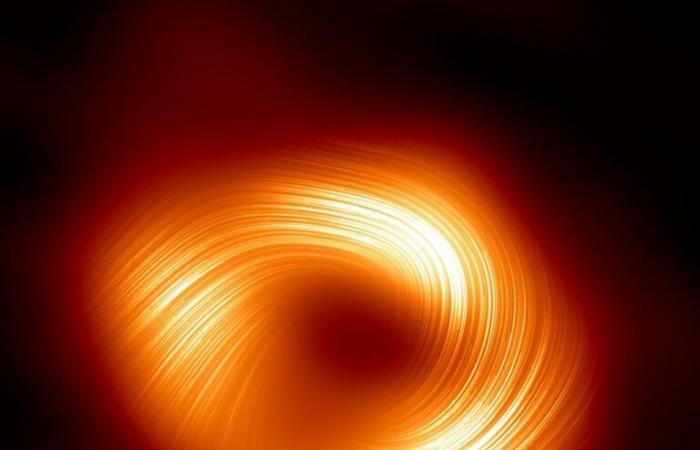A new image from the Event Horizon Telescope (EHT) collaboration has revealed strong, organized magnetic fields spiraling from the edge of the supermassive black hole Sagittarius A* (Sgr A*). With observations made for the first time in polarized light, the new image of the monster hiding in the heart of the Milky Way revealed a magnetic field with a structure very similar to that of the black hole at the center of the galaxy M87, suggesting that intense magnetic fields can be common to all black holes. This similarity also points to the existence of a hidden jet in Sgr A*. The results were published today in the specialty journal The Astrophysical Journal Letters.
In 2022, scientists revealed the first image of Sgr A* during press conferences around the world, including at the European Southern Observatory (ESO). Although the Milky Way’s supermassive black hole, which is about 27,000 light-years away from Earth, is at least a thousand times smaller and less massive than M87, the first black hole to be photographed, the Observations revealed that the two have a very similar appearance, which led scientists to wonder whether these black holes shared common characteristics beyond their appearance. To find out, the team decided to study Sgr A* in polarized light. Previous studies of the light around the M87 (M87*) black hole revealed that the magnetic fields around it allowed the black hole to launch powerful jets of material into its surroundings. Building on this work, new images have now revealed that the same may be true for Sgr A*.
“What we are observing are strong, twisted and organized magnetic fields near the black hole at the center of the Milky Way.,” said Sara Issaoun, a NASA Hubble Fellow Einstein Fellow working at the Center for Astrophysics | Harvard & Smithsonian, USA, and co-leader of the project. “If we join That is, the fact that Sgr A* has a polarization structure very similar to that observed in the much larger and more powerful black hole M87*, it seems to us that strong and ordered magnetic fields are fundamental to the way black holes interact with gas and the matter that surrounds them.”
Light is an oscillating, or moving, electromagnetic wave that allows us to see objects. Sometimes the light oscillates in a preferred orientation, which we call “polarized”. Although we are surrounded by polarized light, to human eyes this light is indistinguishable from so-called “normal” light. In the plasma that surrounds these black holes, particles that revolve around the magnetic field lines give it a polarization pattern perpendicular to the field, which allows astronomers to see in great detail what is happening in the regions of the black holes and map their magnetic field lines.
“By imaging in polarized light glowing hot gas near black holes, we are directly inferring the structure and strength of the magnetic fields that accompany the flow of gas and matter that the black hole consumes and ejects.”, explains Angelo Ricarte, fellow at the Harvard Black Holes Initiative and co-leader of the project. “Polarized light teaches us more about astrophysics, the properties of gas and the mechanisms that occur when a black hole attracts matter towards itself.”
However, imaging black holes in polarized light is not as easy as wearing a pair of polarized sunglasses. This is particularly true in the case of Sgr A*, which changes so quickly that it cannot stand still for us to take photographs of it. To capture images of this supermassive black hole we need sophisticated tools, better than those previously used to capture M87*, a much more stable target. EHT Project Scientist Geoffrey Bower of the Academia Sinica Institute of Astronomy and Astrophysics in Taipei explains, “Since Sgr A* moves a lot while we try to photograph it, it was even difficult to get its image in unpolarized light“, adding that the first image was, in reality, created from an average of several images. “We were relieved that the polarized image was at all possible. Some models proved to be too confusing and turbulent to be able to construct a polarized image, however Nature was not as cruel to us as the models anticipated.”
Mariafelicia De Laurentis, EHT Project Deputy Scientist and Professor at the University of Naples Federico II, Italy, said: “With a sample of two black holes — with very different masses and very different host galaxies as well — it is important to determine where they agree and disagree. Since both have strong magnetic fields, this may well be a universal and perhaps fundamental characteristic of these types of systems. One of the similarities between these two black holes could be a jet, but although we spotted a very obvious one in M87*, we haven’t yet found one in Sgr A*”.
To observe Sgr A*, the collaboration brought together eight telescopes from around the world into a single Earth-sized virtual telescope, the EHT. The Atacama Large Millimeter/submillimeter Array (ALMA), of which ESO is a partner, and the Atacama Pathfinder Experiment (APEX), both in northern Chile, were part of the network that carried out the observations in 2017.
“As the largest and most powerful of the EHT telescopes, ALMA played a key role in obtaining this image”, says María Díaz Trigo, Scientist at ESO’s European ALMA Programme. “ALMA is now planning an ‘extreme refurbishment’, the Wideband Sensitivity Upgrade, which will make it even more sensitive and maintain it as a key infrastructure in future EHT observations of Sgr A* and other black holes.”
The EHT has carried out several observations since 2017 and observations of Sgr A* are scheduled again in April 2024. Every year the images improve, as the EHT incorporates new telescopes, greater bandwidth and new observing frequencies. Expansions planned for the next decade will allow high-fidelity movies of Sgr A*, could reveal a hidden jet, and allow astronomers to observe similar polarization features in other black holes. However, extending the EHT into space will allow us to obtain clearer images of black holes than ever before.
European Southern Observatory
Tags: Astronomers discover spiraling magnetic fields edges Milky Ways black hole
--





